
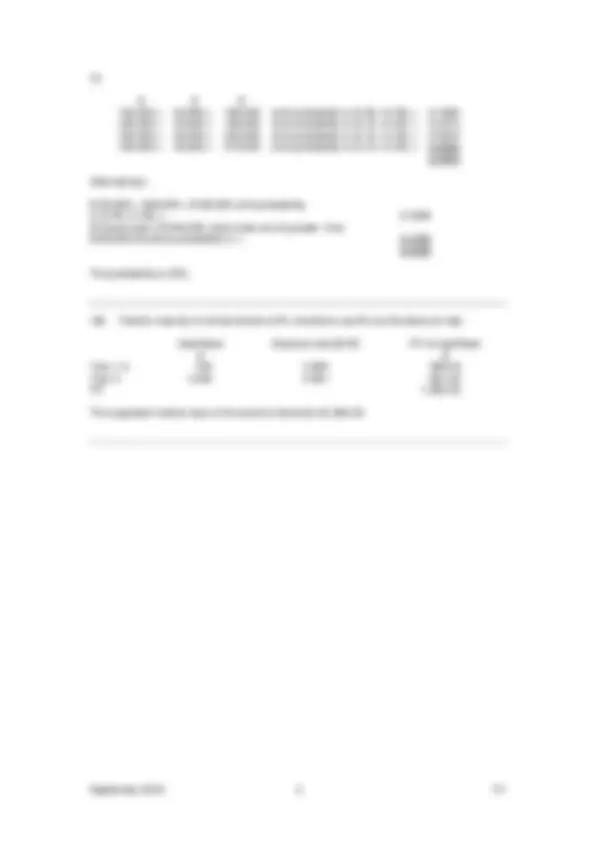
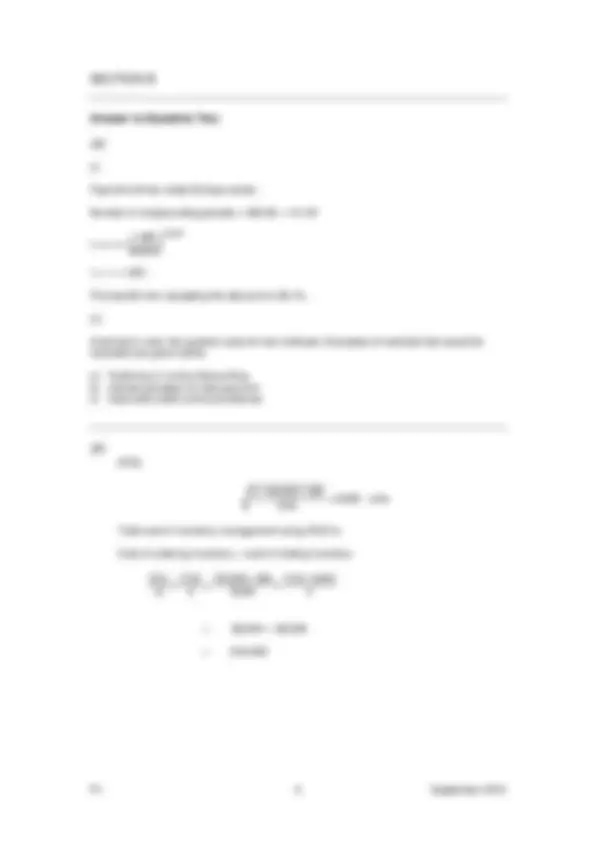
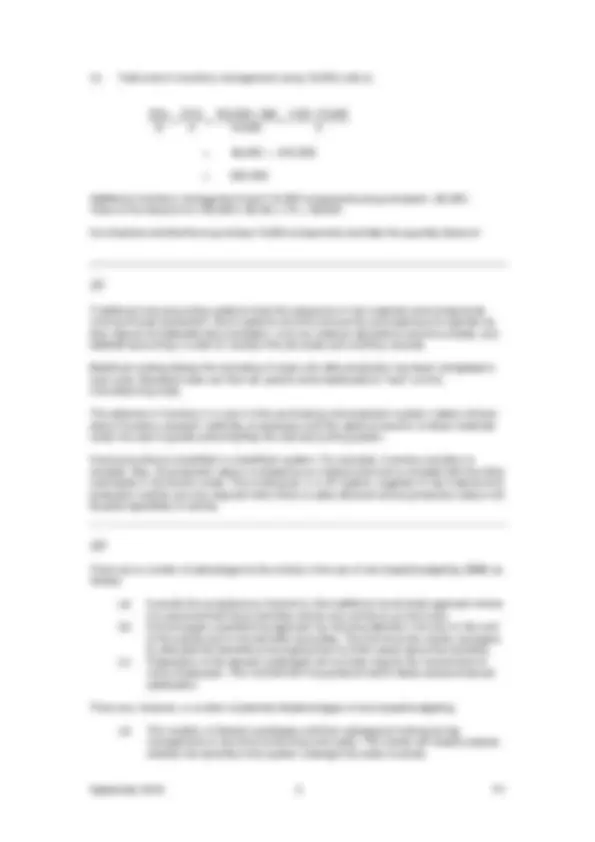

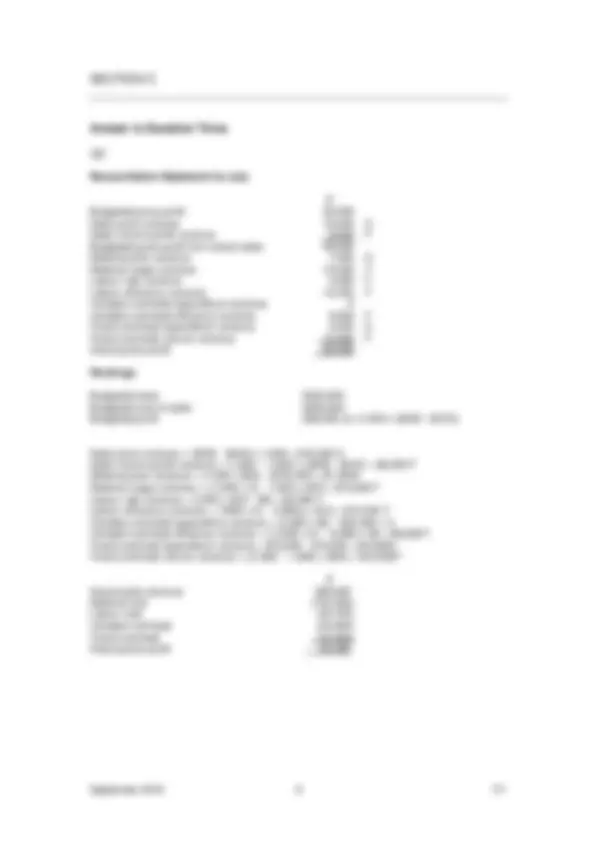
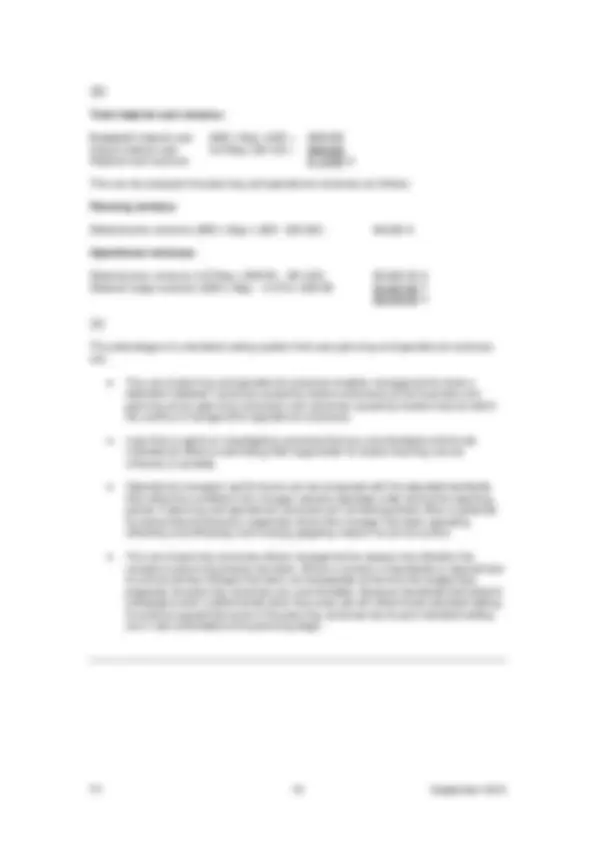
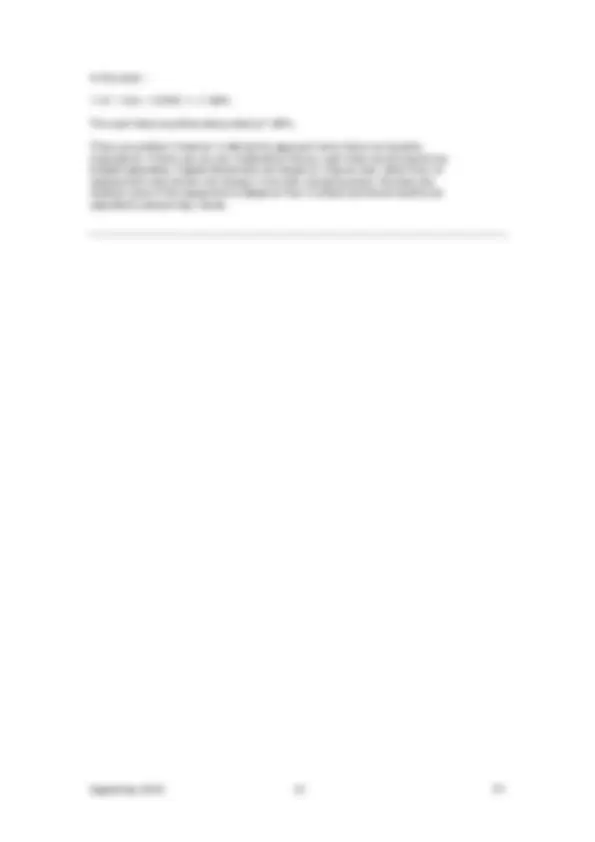
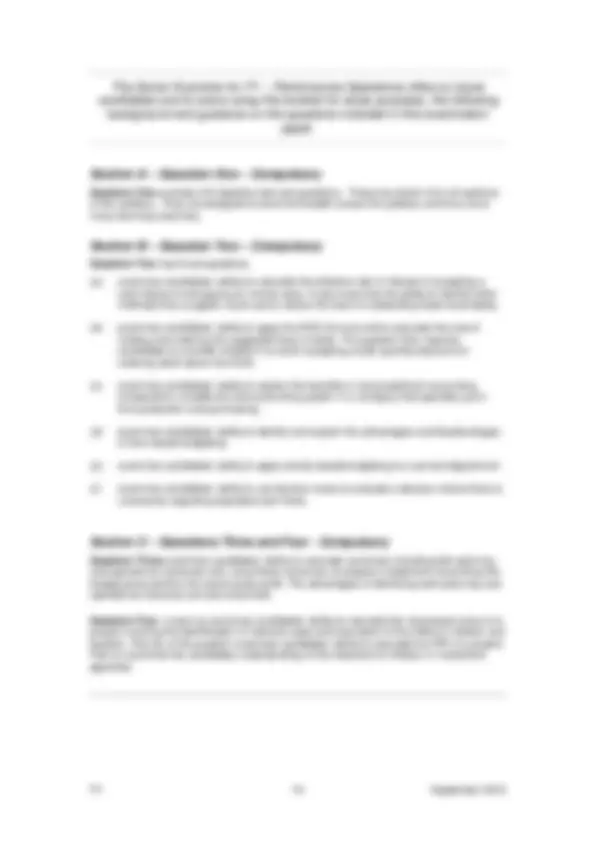


Study with the several resources on Docsity

Earn points by helping other students or get them with a premium plan


Prepare for your exams
Study with the several resources on Docsity

Earn points to download
Earn points by helping other students or get them with a premium plan
Community
Ask the community for help and clear up your study doubts
Discover the best universities in your country according to Docsity users
Free resources
Download our free guides on studying techniques, anxiety management strategies, and thesis advice from Docsity tutors
This can be analysed into planning and operational variances as follows: Planning variance. Material price variance ((890 x 5kg) x ($20 ...
Typology: Exercises
1 / 14

This page cannot be seen from the preview
Don't miss anything!









September 2010 1 P
1.1 The correct answer is A.
1.2 (102 + 67 - 54) = 115 days
The correct answer is B.
The correct answer is D.
1.4 If the maximin rule is applied, the highest of the worst profit for each of the three projects is $450,000 i.e. project C.
The correct answer is C.
P1 2 September 2010
Minimax Regret Table Market Conditions Projects
A B C D
Poor ($300,000) 0 ($250,000) ($340,000)
Average ($80,000) 0 ($50,000) ($150,000)
Good ($200,000) ($500,000) 0 ($250,000)
The maximum regret for Project A is $300, The maximum regret for Project B is $500, The maximum regret for Project C is $250, The maximum regret for Project D is $340,
Therefore if the company wants to minimise the maximum regret it will invest in project C.
The correct answer is C.
July Aug Sept Oct Nov Dec Total Credit sales
Cash Collected: $ Outstanding receivables June 65, Credit sales 246, 311, Less receivables at 31 December
100% December credit sales (46,000) 50% November credit sales (22,000) 25% October credit sales Total cash collected
(i)
The expected value of fixed costs is:
($80,000 x 0.40) + ($130,000 x 0.45) + ($160,000 x 0.15) = $114,
The expected value of variable costs is:
($30,000 x 0.25) + ($40,000 x 0.35) + ($50,000 x 0.40) = $41,
The expected value of total costs is therefore $114,500 + $41,500 = $156,
P1 4 September 2010
(i)
Payment will be made 30 days earlier.
Number of compounding periods = 365/30 = 12.
1 + r = 1.
The benefit from accepting the discount is 36.1%
(ii)
Examiner’s note: the question asks for two methods. Examples of methods that would be rewarded are given below.
a) Factoring or invoice discounting b) Interest penalties for late payment c) Improved credit control procedures
6 , 000 units
Total cost of inventory management using EOQ is:
Cost of ordering inventory + cost of holding inventory
ChQ Q
DCo ×
September 2010 5 P
(ii) Total cost of inventory management using 10,000 units is:
ChQ Q
DCo ×
Additional inventory management cost if 10,000 components are purchased = $2, Value of the discount is (150,000 x $2.00) x 1% = $3,
It is therefore worthwhile to purchase 10,000 components and take the quantity discount
Traditional cost accounting systems track the sequence of raw materials and components moving through production. Such systems are time consuming and expensive to operate as they require considerable documentation, such as material requisitions and time sheets, and detailed accounting in order to maintain the job cards and inventory records.
Backflush costing delays the recording of costs until after production has been completed or even sold. Standard costs can then be used to work backwards to 'flush' out the manufacturing costs.
The absence of inventory in a just-in-time purchasing and production system makes choices about inventory valuation methods unnecessary and the rapid conversion of direct materials costs into cost of goods sold simplifies the cost accounting system.
Cost accounting is simplified in a backflush system. For example, inventory valuation is avoided. Also, all production labour is treated as an indirect cost and is included with the other overheads in conversion costs. This is because, in a JIT system, supplies of raw material and production activity are only required when there is sales demand and so production labour will be paid regardless of activity.
There are a number of advantages to the charity in the use of zero based budgeting (ZBB) as follows:
(a) It avoids the complacency inherent in the traditional incremental approach where it is assumed that future activities will be very similar to current ones. (b) It encourages a questioning approach by focusing attention not only on the cost of the activity but on the benefits it provides. This will force the charity managers to articulate the benefits encouraging them to think clearly about the activities. (c) Preparation of the decision packages will normally require the involvement of many employees. This involvement may produce useful ideas and promote job satisfaction.
There are, however, a number of potential disadvantages of zero based budgeting:
(a) The creation of decision packages and their subsequent ranking by top management is very time consuming and costly. The charity will need to assess whether the benefits of the system outweigh the costs involved.
September 2010 7 P
(i)
Product Q Product R Total Number of batches 80,000/5,000 = 16 120,000/4,000 = 30
Machine set ups per batch
Total number of set ups
Budgeted cost of set ups
Budgeted cost per set up
Budgeted cost per unit of product Q:
Total number of set ups = 64 Total budgeted set up costs = 64 x $600 = $38, Budgeted set up costs per unit = $38,400/80,000 units = $0.48 per unit
(ii)
Examiner’s note: the question asks for two benefits. Examples of points that would be rewarded are given below.
(a) Activity based budgeting provides a clear framework for understanding the link between costs and the level of activity.
(b) Activity based budgeting allows the ranking of activities and the determination of how limited resources should be allocated across competing activities.
(c) Activity based budgeting is useful for the review of capacity utilisation. If it is known that the resources devoted to a particular activity are above those currently required then these resources can be reduced or redeployed.
(d) Activity based budgeting allows the identification of value added and non-value added activities and ensures that any budget cuts are made to non-value added activities.
P1 8 September 2010
Decision tree: advertise programme or not
Therefore the programme should be advertised.
40 students $100,
No Increase 35%
50 students $150,
25 students $25,
20 students $
Poor 60%
Good 40%
Good 40%
Advertise
Don’t Advertise
No Increase 75%
Increase 25%
Increase 65%
Poor 60%
40 students $115,
20 students $15,
P1 10 September 2010
Total material cost variance:
Budgeted material cost (890 x 5kg) x $20 = $89, Actual material cost 4,375kg x $21.60 = Material cost variance
This can be analysed into planning and operational variances as follows:
Planning variance
Material price variance ((890 x 5kg) x ($20 - $20.90)) $4,005 A
Operational variances
Material price variance (4,375kg x ($20.90 – $21.60)) $3,062.50 A Material usage variance ((890 x 5kg) – 4,375) x $20.90 $1,567.50 F $5,500.00 A
The advantages of a standard costing system that uses planning and operational variances are:
September 2010 11 P
Number of available room nights per annum = (40 x 360) = 14, Occupancy rate = 80% Occupied room nights per annum = 11, Average room rate = $ Total revenue = $2,880,
With gymnasium and spa:
Occupied room nights (14,400 x 82%) = 11, Average room rate = $262. Total Revenue = $3,099,
Incremental Revenue = $219, Incremental Costs:
Employees (4 x $30,000) = ($120,000) Overheads = ($42,000)
Incremental cash flows in Year 1 = $57,
Cash Flows
Taxation
Year 1 Year 2 Year 3 Year 4 $ $ $ $ Net cash flows 57,600 59,904 62,300 64, Tax Depreciation
Taxable profit 20,100 31,779 41,206 16, Taxation @ 30% 6,030 9,534 12,362 4,
Tax Depreciation
Year 1 Year 2 Year 3 Year 4 $ $ $ $ Tax WDV Residual value
Tax Depreciation
September 2010 13 P
In this case :
1.12 / 1.04 = 1.0769 -1 = 7.69%
The cash flows would be discounted at 7.69%.
There are problem however in taking this approach when there are taxation implications. If there are any tax implications the tax cash flows would need to be treated separately. Capital allowances are based on original cost, rather than on replacement cost and do not change in line with changing prices. Similarly the residual value of the equipment is stated at Year 4 values and would need to be adjusted to present day values.
P1 14 September 2010
Question One consists of 8 objective test sub-questions. These are drawn from all sections of the syllabus. They are designed to examine breadth across the syllabus and thus cover many learning outcomes.
Question Two has 6 sub-questions.
(a) examines candidates’ ability to calculate the effective rate of interest of accepting a cash discount and paying an invoice early. It also examines the ability to identify other methods that a supplier could use to reduce the level of outstanding trade receivables.
(b) examines candidates’ ability to apply the EOQ formula and to calculate the cost of holding and ordering the suggested level of stock. The question then requires candidates to consider whether it is worth accepting a bulk quantity discount for ordering stock above the EOQ.
(c) examines candidates’ ability to explain the benefits of using backflush accounting compared to a traditional cost accounting system in a company that operates just in time production and purchasing.
(d) examines candidates’ ability to identify and explain the advantages and disadvantages of zero based budgeting.
(e) examines candidates’ ability to apply activity based budgeting to a service department.
(f) examines candidates’ ability to use decision trees to evaluate a decision where there is uncertainty regarding expected cash flows.
Question Three examines candidates’ ability to calculate variances including both planning and operational variances and, using these variances, to prepare a statement reconciling the budget gross profit to the actual gross profit. The advantages of identifying both planning and operational variances are also examined.
Question Four, in part (a) examines candidates’ ability to calculate the net present value of a project involving the identification of relevant costs and calculation of the effect of inflation and taxation. Part (b) of the question examines candidates’ ability to calculate the IRR of a project. Part (c) examines the candidates understanding of the treatment of inflation in investment appraisal.